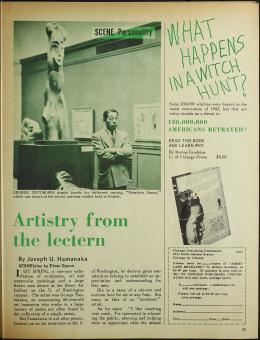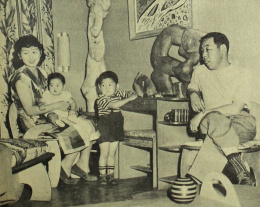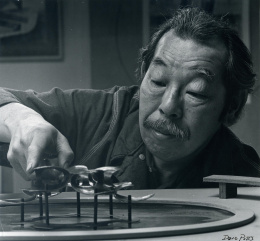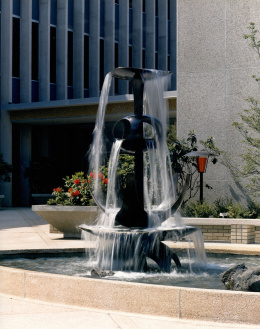George Tsutakawa
| Name | George Tsutakawa |
|---|---|
| Born | February 22 1910 |
| Died | December 18 1997 |
| Birth Location | Seattle, Washington |
| Generational Identifier |
Sculptor, painter and teacher George Tsutakawa is renowned for creating over seventy bronze public fountains that are installed throughout North America and Japan and influencing generations of artists in the Pacific Northwest.
Early Life and Education
Tsutakawa was born in Seattle, Washington, on February 22, 1910, George Washington's birthday, and was thus named after the nation's first president. He was the fourth child and second son of Hisa and Shozo Tsutakawa. The Tsutakawa children spent their childhoods growing up in the Capitol Hill neighborhood in Seattle, in a house near Volunteer Park. In 1917, at age seven, he and one older brother were sent to live with their maternal grandmother in Fukuyama, Japan, while his father, Shozo, went back and forth between the United States and Japanese port cities to manage the family's import/export business, Nichibei Nakagai Shoukai, or the Japan America Trading Company. Over the next few years, all four children were sent to live with their grandmother in Japan. When their mother Hisa died in the flu epidemic of 1918, father Shozo remarried and mostly remained in Japan, leaving his two brothers to remain in Seattle to run the business on the American end.
As it happened, Tsutakawa's paternal grandfather was a avid practitioner of traditional Japanese arts such as the tea ceremony, calligraphy, and flower arrangements, which exposed the young boy to a wide variety of cultural traditions and expressions; he also took regular lessons with a Zen master, watched traditional Japanese theater performances, and learned to make pottery. [1] After ten years in Japan, George had decided to quit school and become an artist, rather than join the family's trading company. He spent one summer working with carpenters to build a house near Kobe for his father, then decided to return to Seattle in 1927. [2] He was seventeen years old, and would never see his father again.
Art Student and the Seattle Artists' Milieu
Tsutakawa lived with his uncles Jin and George in Seattle, helping with the Tsutakawa Company while attending Broadway High School on Capitol Hill. The adjustment back to the U.S. was difficult, as Tsutakawa had forgotten his English and felt the inevitable culture clash of re-adapting to American culture and customs. Under these circumstances, Tsutakawa set out to "reinvent" himself. "He clearly chose to construct himself as an American and an art student," [3] With the encouragement of his high school art teacher, in 1932 Tsutakawa enrolled at the University of Washington majoring in art, where he studied with sculptors Dudley Pratt and Alexander Archipenko, along with other renowned artists such as Ambrose Patterson and Paul Bonifas. He also socialized and painted through the 1930s with a circle of talented artists who came to be identified as the "Northwestern School", including Mark Tobey, Morris Graves, Kenneth Callahan, and Guy Anderson. He also met other Japanese American artists such as Shiro Miyazaki, Kenjiro Nomura and Kamekichi Tokita, the latter two of whom ran the successful the Noto Sign Company. He supported himself through school by working at a grocery owned by his uncle, and by working summers at a cannery in Alaska, which gave him the opportunity to visit native villages, examine the carvings on ceremonial buildings and totem poles, and talk to indigenous carvers. He made drawings and detailed linocuts of fish, fishermen, the canneries, and the dramatic Alaskan landscape. [4] After graduating, he worked full-time, managing a retail outlet for his father's import-export company, located at the intersection of Jackson Street and Rainier Avenue South in Seattle. [5]
In 1940, he made a trip to San Francisco to the Golden Gate International Exposition, where he encountered the vivid murals painted inside Coit Tower painted by a group of artists hired by the Public Works of Art Project, (a precursor to the Works Progress Administration) and visited his old friend and mentor Dudley Carter, who had completed a big wooden totem pole for the Expo. Around the same time as this trip, as Tsutakawa was driving over the Cascade Mountains in Washington, a state highway patrolman pulled over and demanded to see Tsutakawa's drivers license and other identification papers. He eventually was released, with the ominous warning, "Be careful," he said, "We have our eye on you." [6] Within a few years, Tsutakawa's life, along with hundreds of thousands of other Japanese Americans, would be irrevocably changed when the Japanese imperial army bombed Pearl Harbor and the U.S. entered World War II.
World War II Military Service
With onset of World War II, Tsutakawa's import export business, with its strong ties to Japan, was confiscated and his uncles Jin and George Tsutakawa were forcibly removed from their homes in Seattle and first sent to the assembly center at Puyallup , and then to an American concentration camp in Minidoka , Idaho. His married sister, Sadako Moriguchi and her family, were sent to the Tule Lake camp in California. Tsutakawa, however, managed to escape incarceration. In early 1942, shortly after Pearl Harbor was bombed, he was inducted into the U.S. Army and sent to Camp Robinson in Arkansas for training. He recalls being taken with other Nisei from the Seattle area to Monterey, California, and then on a troop train with "orders to keep the blinds down, so we can't see outside...I think we were all suspected, you know, still suspected of espionage or some subversive act...Of course we didn't know where we were going, and there was a rumor that we were going to be imprisoned or enslaved or something like that." [7] When the military officers at Camp Robinson discovered that he was an artist, they diverted his work assignment to painting their portraits, and creating murals in the officers' club on a variety of subjects. He also was assigned illustration jobs ranging from training manuals to lettering latrine signs. On weekends, he and other soldiers wandered into nearby Little Rock, where he discovered the African American jazz clubs and later recreated these scenes in a series of pastel drawings. He was, in his words, "the camp commander's pet artist." [8] Despite his favorable treatment, Tsutakawa was made to confront the vulnerability of his Japanese heritage and the conflict of being Japanese American, especially when his uncle George, who had been sent to a high security camp in the southwest, wrote Tsutakawa "many, many letters, asking me, as a member of the United States Armed Forces, if I could be of some assistance in persuading the American military government to free him...He kept writing to me and he wanted me to come to the camp and talk to the camp commander." [9] When Tsutakawa got a furlough, he traveled to the desert to try to help his uncle in earnest, where he was interrogated, had to show all his credentials, and had a limited conversation with his uncle under a guard's watch, though inevitably, he helplessly "...had conversation but there was nothing much I could do." [10]
Tsutakawa was transferred to Camp Shelby to prepare for service with the 442nd Regimental Combat Team, but when his unit shipped out, Tsutakawa, who was ten years older than most of the other recruits, had to have minor surgery, which held him back. It was decided to send him instead to Fort Snelling, Minnesota, to train for the Military Intelligence Service , where he would serve as a Japanese language instructor instead. Being stationed in Minnesota allowed him some time to travel and tour major museums in Minneapolis and Chicago, which broadened his exposure to the larger world of contemporary art. On one trip to visit his sister Sadako in Tule Lake, he met a Kibei from Sacramento named Ayame Iwasa, who was an accomplished koto player and performer of traditional dance. Tsutakawa's sister, her in-laws and Ayame Iwasa's families were friends, so a dinner was arranged at the Iwasa family barrack. Tsutakawa returned to Fort Snelling the following day, but several months later, he unexpectedly sent a letter and an engagement ring to a startled Ayame and her mother, who rejected the initial offer, but eventually agreed to the marriage after a more formal courtship, involving a baishakunin, or marriage go-between. [11]
Marriage and Postwar Career
In 1946, Tsutakawa returned to Seattle and after helping family members re-establish themselves, enrolled at the University of Washington as a graduate student in art under the G.I. Bill. A year later, he married Ayame at the Nichiren Buddhist Temple in Seattle—the couple would eventually have three sons (Gerard, Marcus and Deems;) and a daughter (Mayumi). That same year, Tsutakawa joined the faculty of the University of Washington, teaching Japanese in the Far East Department and as a part-time instructor in the University of Washington School of Architecture. Although his family business had been hit hard by the war, Tsutakawa's sister's husband of the Moriguchi family was able to continue the family's import-export tradition by opening Uwajimaya, an imported Japanese goods and green grocery store in Seattle that is now the largest Asian grocery retailer in the Pacific Northwest. [12]
He eventually taught full-time at the University, and his watercolor paintings, prints, small sculpture, and wood carving began to exhibit in the Northwest Annuals at the Seattle Art Museum, at the Henry Art Gallery, the Zoe Dusanne Gallery, and various other spaces. In 1955, one of his watercolor paintings was accepted into the Biennial Exhibition in São Paolo, Brazil, where it sold. He also received numerous commissions for sculpture, door carvings and gates for local businesses and designed furniture (chairs, tables, and lamps) for clients. In 1956, he returned to Japan for the first time since returning to the United States twenty-nine years earlier, to visit family and attend the opening of an exhibition of his work, along with that of Paul Horiuchi (1906-1999) and Glen Alps, at the Yoseido Gallery in Tokyo. His travels in Japan also included leading tourists through Kyoto, Nara, and Hiroshima.
This re-immersion in traditional Japanese art and aesthetics would have a profound influence on Tsutakawa (and was encouraged by his good friends, the renowned artist Mark Tobey, who had studied art in China and Japan, and painter Paul Horiuchi), as did a book entitled Beyond the High Himalaya, written by U.S. Supreme Court Justice William O. Douglas. Beyond the High Himalaya, describes "obos," or stacks of stones created by Himalayan travelers when they successfully crossed a mountain pass, that grew by adding a stone to a pile left by earlier pilgrims. These spiritual rock forms and his study of Japanese pagoda structures served as major inspirations for a series of Tsutakawa's sculptures and later, for his fountains. In 1958, the board of directors of the Seattle Public Library invited him to create a fountain for the new library then under construction downtown between 4th and 5th avenues. The "Fountain of Wisdom", a silicon bronze abstract design suggestive of obos and totem poles, would become one of Tsutakawa's most well-known and celebrated sculptures. The "Fountain of Wisdom" was the first of the dozens of fountains Tsutakawa would design over his lifetime, which include the "Waiola Fountain" at the Ala Moana Center, Honolulu; the "Song of the Forest" fountain, Sendai, Japan; the "Lotus Fountain" at the Fukuyama Fine Art Museum, Fukuyama, Japan; the "Joshua Green Fountain" at the Washington State Ferry Terminal, Pier 41, Seattle; "Fountain of Reflection," MacKenzie Hall, School of Business, at the University of Washington. [13] Through these years, Tsutakawa was assisted by, and the projects came to be managed by, his son, Gerard, who is also a metal sculptor. While fountain sculptures dominated his work after 1960, he was also prolific in the creation of sumi and watercolor paintings, and wood and metal sculptures. His later commissions included designing medals for the 1962 Seattle World's Fair, the architectural gates at Seattle's Lake City Library and the 1983 memorial sculpture for West Coast Japanese Americans incarcerated during World War II, installed at the fairgrounds in Puyallup , Washington, which formerly served as a temporary detention center for the Seattle area. In this period, Tsutakawa mixed with dancers, musicians, and kabuki and kyogen and bunraku actors from Japan who were invited to participate in grand, celebratory events, and sometimes included celebrated artists living in Seattle, such as Jacob Lawrence. [14]
In 1981, the Emperor of Japan presented him with the Order of the Rising Sun Award, Fourth Class. University of Washington named him Alumnus Summa Laude Dignatus in 1984, and he also received honorary doctorates from both Whitman College, in Walla Walla, and Seattle University in 1986. In 1992, the Wing Luke Asian Museum in Seattle chose Tsutakawa as the recipient of its first lifetime achievement award. He died on December 18, 1997, at age eighty-seven.
For More Information
Holden, Ronald. "An exhibit brings together Tsutakawas past and present." Crosscut.com, November 15, 2010.
Kingsbury, Martha. George Tsutakawa. Seattle: Bellevue Art Museum and University of Washington Press, 1990.
Leonard, Nagisa. " A Review of Reflection and Abstraction: George Tsutakawa Centennial. " International Examiner, Dec. 1, 2010.
Clemens, Gayle. " Review: Tsutakawas' Compelling Works Are Shown Together in Seattle Exhibition. " Seattle Times, Nov. 11, 2010.
" George Tsutakawa, 1947." An essay from the University of Washington research showcase, 1997.
Woodside/Braseth Gallery. " George Tsutakawa. "
Footnotes
- ↑ Martha Kingsbury, George Tsutakawa , Bellevue Art Museum and University of Washington Press, 1990. 22.
- ↑ "George Tsutakawa, 1947," an essay from the University of Washington research showcase, 1997, accessed Aug. 24, 2014 at http://www.washington.edu/research/showcase/1947 .
- ↑ Kingsbury, George Tsutakawa, 29.
- ↑ Deloris Tarzan Ament, "Tsutakawa, George (1910-1997): Master of Fountains," March 15, 2003, Historylink.org, http://www.historylink.org/index.cfm?DisplayPage=output.cfm&file_id=5426
- ↑ "George Tsutakawa, 1947."
- ↑ Kingsbury, George Tsutakawa, 39.
- ↑ Kingsbury, George Tsutakawa. 40.
- ↑ Ament, Historylink.org.
- ↑ Martha Kingsbury, George Tsutakawa. 40.
- ↑ Kingsbury, George Tsutakawa, 40.
- ↑ Ament, Historylink.org.
- ↑ Ament, Historylink.org.
- ↑ "George Tsutakawa, 1947."
- ↑ Robin Updike. "George Tsutakawa Obituary." Seattle Times , December 19, 1997. http://community.seattletimes.nwsource.com/archive/?date=19971219&slug=2579035
Last updated Dec. 21, 2023, 2:24 a.m..

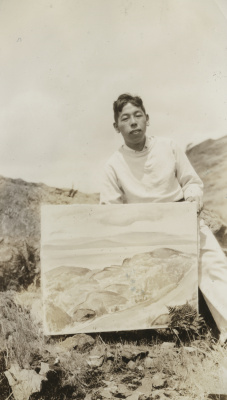 Media
Media
